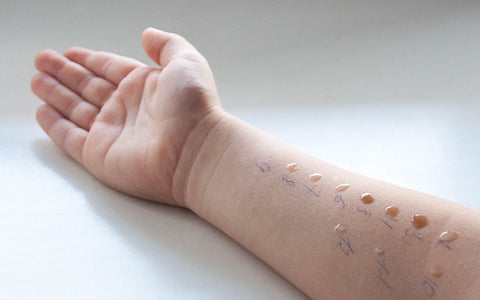Allergy testing for kids
Allergy tests can help by narrowing down the list of possible culprits for your child’s symptoms. But a positive result doesn’t necessarily mean your child is allergic to that trigger. Your GP or allergist will interpret the results for you.
Allergy testing for kids is a significant milestone for parents trying to identify their child’s triggers. But it isn’t without its own set of anxieties. There are several types of allergy tests (and different names for the same tests). And few of us know exactly what’s involved until we need one for ourselves or someone in our family.
That’s what this article is for. Read on to find out why your GP might suggest allergy testing for kids. Also why they might suggest a particular test for your child. If you haven’t had that conversation yet, maybe we can help you figure out what to ask when you do.
Allergy testing for kids: Why?
The best first question. Allergy symptoms can be bothersome and worrisome in varying degrees. They may affect your child’s eyes, nose, throat, chest, skin and digestion. Or their whole body if it’s a severe allergic reaction. That’s a good enough reason to tackle symptoms right now. But allergies can also influence long-term health if left untreated.
Managing symptoms after allergy testing for kids
Allergy testing for kids is a first step. It can help your child get a diagnosis (of course, it may not be allergy). Then you and your doctor will make a plan, starting with what to avoid and how to avoid it. Hopefully that means your child has fewer symptoms. If not, they'll be able to get the antihistamine, corticosteroid or other relief they need. Immunotherapy may be an option too. This is a long-term treatment for certain allergies.
Allergy testing for kids: the long view
How your child reacts in an allergy test can sometimes be a helpful clue to how their condition might develop. For instance, a strongly positive result tends to suggest kids are less likely to grow out of a food allergy.
Testing can also lead to a full diagnosis for young children who are allergic to one food and may later react to others. Meanwhile early sensitisation to cow’s milk, hen’s eggs and allergens you breathe in can develop into lower respiratory symptoms. But treating allergies early may help lower the risk.
Common types of allergy testing for kids
There are three main types of allergy testing for kids (and grown-ups).
- Skin tests – different tests for different types of allergic conditions
- Blood tests – useful for children with a skin condition that may interfere with a skin test
- Challenge tests – may be done when blood and skin test results are inconclusive
These tests look for Immunoglobulin E (IgE) antibodies in your child’s blood or evidence of their presence. The immune system makes the antibodies as protection against substances it thinks are a threat. Sometimes it gets it wrong. Pollen, animal dander, dust mites, peanuts, latex, even insect stings are generally harmless. But if you have an allergy to one of them, the antibodies set off a reaction to expel it from your body as fast as possible.
Does an allergy test show what your child is allergic to?
Not exactly. And here’s why. IgE antibodies are specific to a substance or allergen. But a positive test result only shows sensitisation. It doesn’t necessarily mean your child is allergic to that trigger.
The first encounter with an allergen programs your child’s immune system. They have IgE antibodies and their body is ready to react if they meet it again. But not everyone will develop allergy symptoms even though they carry the antibodies and test positive. This is known as being sensitised but not allergic.
Test results can help diagnose allergies by narrowing down the list of possible culprits for your child’s symptoms. Your doctor will interpret them for you.
From allergy testing for kids to a diagnosis
Be ready to answer questions about your child’s symptoms, from runny nose to skin rashes and everything in between. An allergy diary can be a useful way of keeping track of this:
- When allergy symptoms started
- How long they last for
- How badly they affect your child
- Times of the year or places that make symptoms worse
- What you think might be the trigger
If you have relatives with allergies, that’s important information too because it tends to run in families.
What age does allergy testing for kids start?
Children can get tested at any age but IgE levels may be very low in newborns making diagnosis tricky. Also, the number of things a tiny baby can be allergic to may be limited. After all, you usually need to encounter a substance twice to develop an allergy.
Sensitisation tends to start with eggs, cow’s milk and peanuts. Reactions may show first on your child’s skin, followed by other food allergy symptoms with weaning. Symptoms from indoor environmental allergies to dust mites, cockroaches and pets may appear when they’re toddlers.
What kids actually feel during an allergy test and how they feel about it will vary. Talk to them beforehand so they know what to expect.

Allergy testing for kids with skin tests
Skin tests happen at the doctor’s office in case of severe allergic reactions which can be a medical emergency. If your child takes antihistamines to ease their allergy symptoms, they’ll need to stop a few days before their skin testing appointment. Follow your allergist's instructions.
-
Skin prick test: Tends to be the first choice of test, also called a prick test, scratch test or percutaneous test. Skin prick tests can help identify allergies to for example pollen, dust mites, animal dander, mould or latex. Food allergies are complex and may need other tests too.
Skin prick testing is used for penicillin allergy. It’s less reliable for other drug allergies where a negative result may not be conclusive. Skin prick tests are usually not painful. A drop of liquid containing an allergen is placed on your child’s arm. Little children often can’t resist itching so may have the test on their back. The skin is then gently pricked and checked for a response in 15-20 minutes. A small red swelling (wheal) like a mosquito bite shows your child is sensitised.
The next step after a negative or inconclusive result may be an intradermal test.
- Intradermal test: Sometimes called a skin injection test. Intradermal testing is often done to identify insect venom or drug allergies. It involves injecting a small amount of allergen just under the skin on your child’s arm, which may be uncomfortable. The allergist or nurse will check for wheals after 15 minutes.
- Patch test: Normally done to identify non-IgE allergies causing skin inflammation (contact dermatitis). Patch tests can be for latex, a chemical, metal, resin and or drug. It involves taping small patches carrying the allergens to your child’s back. The reaction can take 48 hours or more after patch testing to show.
Allergy testing for kids with blood tests
Your allergist may suggest a blood test if your child needs to keep taking medications that could interfere with a skin test. Also if they have particular skin conditions. Or have ever had a severe allergic reaction. The sample goes off to the lab so you won’t get the allergy test results that day.
- Allergy blood test: This involves taking a small sample from your child’s arm or with a finger prick. The lab looks for specific IgE antibodies in the blood indicating sensitization. Finger pricks and needles are no one’s favourite thing. Children may be able to have numbing cream before allergy blood tests taken from their arm. That’s as long as they’re not allergic to lidocaine.
- Component test: It's a variation of the allergy blood test taking a more detailed look at the triggers. There may be several proteins in a substance that can cause allergy symptoms. A component test can tell you which one your child is sensitised to. That’s helpful if they react to peanuts, tree nuts or insect venom because some proteins in these allergens are more likely to set off a severe reaction.
-
Home allergy testing: Look for tests that detect IgE; not all do. This isn’t a short cut to a diagnosis as you’ll need to ask a medical expert to interpret the results. But a home allergy test can give you the confidence to book an appointment. There are two types. Both involve taking a small blood sample from your child’s fingertip.
Home to lab means you send the sample off for analysis like our Home Allergy Test. There are also allergy self-test kits. You test the blood yourself and get a result soon after. The number of allergens may be fewer.

Allergy testing for kids with challenge tests
This test exposes your child to their possible trigger, usually a food or drug. The aim is to set off their allergy, if it exists, under medical supervision. The allergist or allergy nurse monitors your child for any reaction. Your child will need to stop taking antihistamine before the challenge as it can mask symptoms. Of course, always follow your allergist's instructions.
-
Oral food challenge (OFC): May be the next step when other tests are inconclusive or to see if a child has outgrown a food allergy. The food challenge starts with a tiny amount of the potential trigger and increases gradually. If your child reacts, you know they must avoid certain foods.
The clinic may ask you to bring food with you for the test, particularly for little kids and fussy eaters. It can be calming to have a favourite plate and utensils. And toys as you’ll have to wait for a few hours after testing in case of a delayed reaction.
- Oral drug challenge: Can help to confirm your child is not allergic to a medication before it’s prescribed. The challenge starts with a small dose and builds up step by step as long as there’s no sign of a reaction. Kids who can’t take the oral medication may have injections instead.
Allergy testing for kids: Next steps
Your allergist will look at the results alongside your child’s detailed clinical history and symptoms. It’s not unusual for skin prick tests and allergy blood tests to be inconclusive. You may get false positives or negatives. In which case your child may need a different test to help make the diagnosis.
One we haven’t mentioned yet is a breath test or lung function test (spirometry). Your child may have done one already as part of a physical examination if they get lower respiratory symptoms. It means blowing into a tube connected to a computer. The allergist or nurse will explain what’s going to happen but children may find the process a little scary. Tell them astronauts do the very same test.



